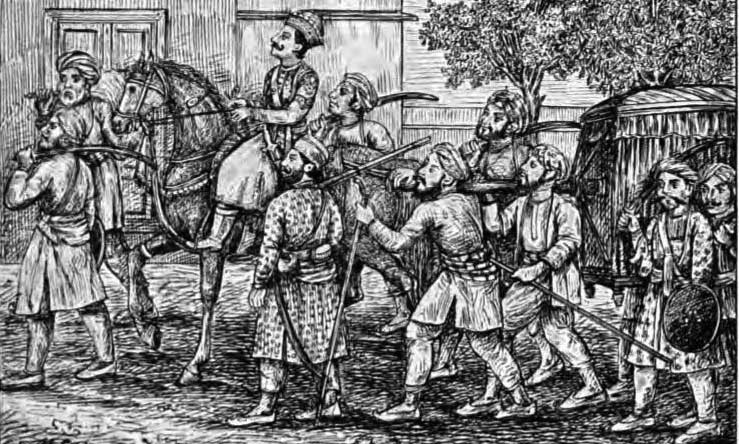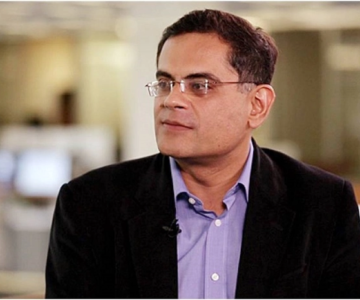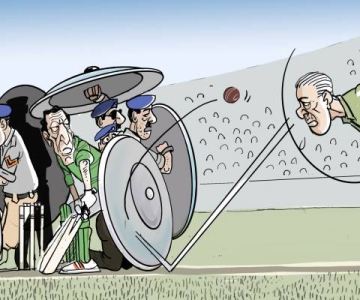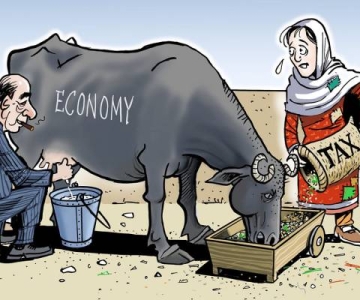Story telling has been a primordial urge, never quite expressed in its fullest measure, but always lingering and floating like life. There was a sub-continent before the colonial interaction that brought in its wake an aesthetic hardened by the industrial revolution and its uniformity of life and space. This was a world rich with myriad identities, of whispers and tales all interlaced in a peculiarly complex kaleidoscope. Since the 19th century that particular aspect of folk story telling and transfer of generational accounts gave way to what is now known as education and knowledge – instruments and reflections of power and a linear world view set elsewhere but adapted awkwardly to the local context.
This is why Simorgh Women’s Resource and Publication Centre in Lahore, under the leadership of Neelum Hussain, have undertaken the challenging task of reclaiming the rich heritage that lies in our folklore especially that of the Punjab. ‘The Romance of Raja Rasalu and Other Tales’ is a stunning compilation of the romance of Punjab’s legendary hero, Raja Rasalu and, while it draws heavily on the colonial storytellers, the book twists the narrative in a manner that brings us closer to the origins of our cultural sensibilities. The tales are sheer magic. The romance, the intrigue, the bravery and the integrated nature of human existence where it finds communication even with birds and trees comes to a full life throughout the narrative.
It is one thing to produce an admirable compendium but it is another matter to ensure that the purpose and spirit of the tales are adequately reflected in the illustrations. This particular touch of originality is provided by the eminent artist Laila Rehman whose breathtakingly attractive illustrations add a new layer of meaning and sensibility to the folk stories. It is, therefore, as has been rightly stated in the introduction, a book for pleasure: a pleasure that moves beyond the immediate and the momentary and merges into the real or imagined pleasure of living. Laila’s paintings and sketches are evocative enough to generate a parallel story within the larger narrative. It is as if the reader is traversing into several worlds. One minute you are locked in the words with imagination rescuing the linearity of the printed letters and another minute imagination and its scope are enlarged, tossed over and often chastened by the sheer colours and experiments of the palette. The sketches, graphics and canvasses become alive and converse with the reader.
The compilation of stories works in a twofold manner whereby the first section deals with Raja Rasalu’s entire legend. Rasalu was the son of Raja Salwahan of Sialkot and a descendant of Vikramjit. The epic narrates high romance and Rasalu’s grand deeds with tons of magic and comedy. It is said that Rasalu’s legend corresponds to 800 A.D. even though there is no evidence to confirm it. But the tales of his life have been preserved by the circle of story tellers in the Punjabi settlements. Rasalu is embedded in our part of the Punjab; for instance, Tilla Jogian (where he meets the legendary fakir) is close to Jhelum city, the location where Rasalu defeated the giants is located in today’s Attock and so on. However, the tales are not geographically specific or fixed in any moment of time for, like any other folk narration, these tales deal with essential urges and imperatives of human existence-the need to live, seek and attain.
The second collection of stories pertains to shorter versions of particular tales invoking magic, romance and comedy. These are particularly delightful for many of them are funny, sometimes bawdy and amazingly pertinent even in the fissured and depressing globalised world we live in.
Neelum Hussain provides an erudite introduction that compares the various versions, elaborates on their nuanced differentials and sets the context for the lay and specialised reader alike. For instance, she mentions how the Punjabi wonder tales, not unlike South Asian in general, twist gender identities and play with the fixed notions of personal identity. For instance, Rasalu’s ‘betrothed’ teases him:
“Ho rider of the dark grey mare
Did you forget to bind your hair?
Like some girls’ all loosely tied
It flies about from side to side”
But the wonderland does far more than just such wordplay. It also blurs the differences between heroes and villains and urges the understanding of the villain. Such fluidity in these tales also confirms their egalitarianism and focus on the human. Above all, as Neelum Hussain, aptly puts “There is no room for any dogma in the comic tale.” This is why the folk and fairy tales and the world they weave are beyond the confines and oppressive structures imposed by the clergy and the establishment.
The lived experience of ordinary people or the common folk, as we often call them rather brutishly, is what that makes these tales universally accessible, understandable and enjoyable.
The three sources of the book’s materials are: Flora Annie Steel, R.C. Templeton and Charles Swynnerton, the colonial researchers who so painstakingly transcribed these tales from the Punjabi language through primary sources i.e. the bards and story tellers. Notwithstanding the warnings given by Edward Said in accepting colonial Orientalism, one has to ruefully admit that such an incisive and thorough labour of love was only done by the ‘white masters’. South Asia’s repugnant ruling classes remain bickering pygmies to date. And, about the scholarship and originality of knowledge production, the less said the better for the two centuries old drought refuses to go away. Specifically, this is truer for Pakistan than perhaps the other South Asian countries. For the Pakistani establishment and intelligentsia, increasingly becoming inseparable, have discarded and trashed their heritage in the pursuit of power, be it the Oxbridge brigade or the US mainstream lackeys, their intellect, alas, remains subservient and refuses to leave the dome like a trapped pigeon.
Hence my boundless excitement and absolute pleasure to have encountered the ‘The Romance of Raja Rasalu and Other Tales’ that defies obscurantism and our collective inertia. I only wish that this book could become more accessible to a wider array of readers, children and students across Pakistan. More importantly, it should be published in Urdu language for a broader audience within the country. Some day we have to rescue our rich secular and egalitarian heritage. I think a great beginning has been made by Simorgh Women’s Resource and Publication Centre.
Raja Rasalu and Raja Sirikap (excerpt from the book)
“Tha very day, having said farewell to the hedgehog, Raja Rasalu and his companions set forth on their journey towards Sirikot, the Fort of Skulls, and at the close of day they were half way on the road to Sirikap’s capital. There he dismounted and pitched his tent and having seen to the needs of his companions and his own supper, he walked out to look for the body of Sirisuk, the brother of Raja Sirikap, and there came a fierce storm and the sky was filled with thunder and lightning, so he looked for shelter and found none except in an old graveyard where a headless corpse lay stiff and cold on the ground. Turning to his parrot Shadi, he said, “This man is dead! Who will now advise us about Raja Sirikap?”
“Offer your prayers to God”, answered Shadi, “and the body will sit up and talk to you, for he is not really dead, but lies under the spell of Raja Sirikap’s magic”.
Then Rasalu, having first made his ablutions, prayed to God and said
“God, within the forest lonely
Night hath fallen o’er the dead,
Grant him life a moment only,
Light within his eyelids shed,
Then this corpse that lieth pronely,
Four words to speak will lift his head.”
And immediately the corpse arose and sat beside him. Astonished, Rasalu spoke to it
“The storm beats fierce and loud,
The clouds rise thick in the west,
What ails thy grave and thy shroud,
O corpse, that thou canst not rest ?”
Then the headless corpse replied
“On earth I was even as thou,
My turban awry like a king,
My head with the highest, I trow,
Having my fun and my fling”,
Fighting my foes like a brave,
Living my life with a swing.
And, now I am dead,
Sins, heavy as lead,
Will give me no rest in my graver!
“But who are you, that disturbs me tonight?”
“I am Rasalu”, answered the Raja.
“Are you the real Rasalu, or another?” asked Sirisuk, the corpse, for that is who it was.
“Tell me what you do here, and where are you going?”
“I am going to play chaupar with your brother Sirikap”, answered Rasalu, and when Sirisuk the corpse heard this, he laughed a dead mars laugh.
“Why do you laugh?” asked Rasalu.
“I was his own brother”, said the corpse, “and yet he killed me without pity. We often played chaupar and I was always the winner – excepting once. Once only did my brother win, and then he claimed my head. Thinking that as he was my brother, he spoke in jest, I bent my head before him. He took it off with a single blow and then, fastening a rope to my feet, threw me out of the city.
“Do you think he will spare you? You do not even have an army, while he commands a host of thousands! How will you cope with him? It has been twelve years since anyone spoke to me, and I would be sorry if you were to lose your life at my brother’s hands.”
“Assisted by your advice”, answered Rasalu, “I trust I shall be able to defeat him”.
“When you draw near the city”, said Sirisuk, “Sirikap will raise a magical storm strong enough to blow you away to some other country. Failing that, he will bury you in a storm of magical snow. If you escape even that, you will reach the city and strike the gong that hangs at the castle gate. The moment the noise of the gong strikes your ears, you will go mad and be driven out of the city. And peradventure if you avoid even that peril, you will have to pass under the swing of his daughter, Chandai, who swings in the porch, which is fifty feet high. The moment you pass under it, you will begin to rave and rant and become the sport of the palace inmates, for whoever passes beneath the swing goes mad. But if by good fortune and the favour of God, you overcome this danger, Raja Sirikap will play chaupar with”.
Excerpt from the book.
First published in THE FRIDAY TIMES, Lahore



